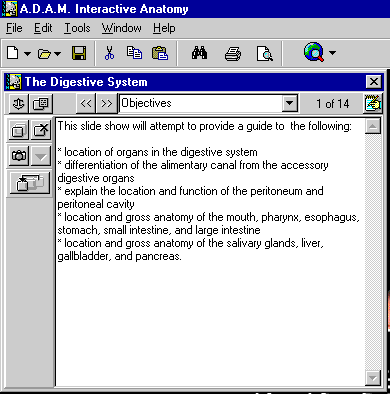| 1. | Introduction | ||||||
| 2. | Development | ||||||
|
|||||||
| 3. | Evaluation | ||||||
|
|||||||
| 4. | Results | ||||||
|
|||||||
| 5. | Discussion | ||||||
| 6. | Conclusion | ||||||
| 7. | References |
![]()
Online Anatomy Lab (OAL): A Self-Regulated Approach to the Instruction
of Human Anatomy
Sally
G. Boudinot & Bradley C. Martin
University of Georgia College of Pharmacy
Abstract
The Online
Anatomy Lab was developed for first year pharmacy students to address
a set of foundational learning objectives of the University of Georgia
(UGA) College of Pharmacy Doctor of Pharmacy curriculum. This report describes
how a self-regulated format was developed and instituted to accomplish
two sets of goals identified as critical in the education of professional
pharmacy students: content-oriented goals related directly to the learning
of human anatomy and goals related to professional and personal development.
The development, implementation, and evaluation of Online Anatomy Lab
will be described.
1. Introduction
We developed
and implemented a self-regulated, instructor-guided module to facilitate
learning in the human anatomy laboratory. Students who complete the course
should be able to do the following:
- identify, by name, significant human anatomical structures;
- describe the functions of these structures;
- define their relationship to larger physiological systems; and
- locate them in a model of the human body and on a patient where appropriate.
OAL supports student achievement of these content-area objectives through the following:
- clear visual images of anatomical structures that can be viewed from different angles by the student;
- lessons that give each student an individual opportunity to step through the identification process and explore the structures in context (rather than with a team of students as common in cadaver lab);
- numerous, self-paced practice opportunities; and
- self-scheduled testing.
In addition to providing a method for mastering human anatomy, OAL offers our students opportunities for professional and personal development. Our goals in these areas relate more to how students learn than what they learn. With the practicing pharmacist in mind, we developed our goals through informal discussions with pharmacist preceptors (pharmacists who work with pharmacy students during practice experiences). With OAL, we sought to
- give students a sense of control over their learning;
- facilitate independent learning;
- foster the development of self-motivation; and
- improve time management skills.
The self-regulated format was selected to accomplish these goals. The high degree of self-control that self-regulated learning affords facilitates the learner's feeling of motivation (Corno & Mandinach, 1983). Self-motivation is highly desirable in the field of pharmacy, where continuing professional education is mandated by regulating boards. Much of the pharmacist's continuing education (CE) is available online or in print as independent study materials.
It can be argued that the mastery of the learning objectives is a "recipience" process, that is, the student's simple acquisition of facts for the short term to successfully complete a quiz (Corno & Mandinach, 1983). This process requires little active engagement by the student, but is appropriate for the lower level skills required in this course. However, when students learn through OAL, they are also required to plan and monitor their activities. Students must plan when to take advantage of the availability of the study resources, schedule the quiz times, and determine how much time is needed for a particular topic. Furthermore, students must evaluate and assess other scheduling needs and prioritize them. They may monitor their progress through the "my record" feature available through the course software, WebCT (WebCT, Peabody, MA, USA). The ability to monitor grades may reinforce positive performance or encourage improvement if students have not performed satisfactorily. In order to successfully complete the module, an average grade of sixty percent must be obtained, and the ability to monitor the quiz grades gives students the capacity to know where they stand at all times. This may facilitate the feeling of being in control.
![]()

